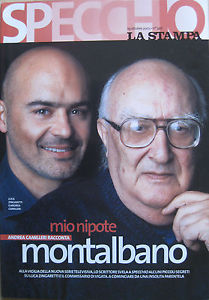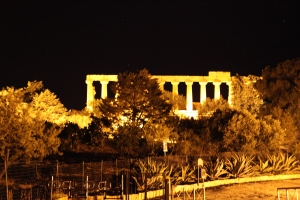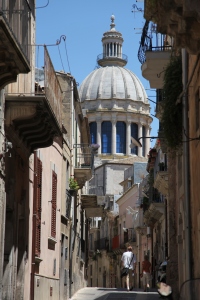An unexpected bonus of starting to write crime fiction is the opportunity to go back to some favourite authors and not only rediscover the fun but also start to work out what they are doing. That is especially the case where the writers run a long series, and as a ‘crime and place” aficionado one of my absolute favourites is the marvellous Andrea Camilleri.
Camilleri, of course, writes that wonderful lot of books set in Sicily and featuring the irascible Commisario Salvo Montalbano. http://www.bestofsicily.com/mag/art62.htm The television series based on the books have been shown around the world and made Luca Zingaretti a global star. Perhaps predictably for Italy, Zingaretti’s brother Nicola is currently the President of the Lazio region that includes Rome, is a former member of the European Parliament and a Democratic Party leader. Camilleri himself could not have done that better.
The first point to make is that the books and the series are set very specifically in just one area of Sicily, the southeast corner effectively running from Syracuse around to Porto Empedocle and Agrigento and the Valley of the Temples. Across that area Camilleri captures the marvellous seaside towns and villages, the stark and rugged uplands and hamlets, the variety of people and, of course, the huge range of food. He was one of the first to make food a central part of the story.
At the heart of this lies the now 90 years old Camilleri’s personal roots in the region. He was born in Porto Empedocle, the tiny harbour down the road from Agrigento and now the doorway to the Scala dei Turchi, the unusual white marl cliffs that have become a recent tourist attraction. The real importance of Porto Empedocle, however, is that Vigata in the books is based on the town with the nearby Agrigento forming Montelusa, the regional centre where Montalbano often has to go for a periodic dressing down. In fact, the small port is now known officially as Porto Empedocle Vigata. http://www.wheninsicily.com/?p=3519
This regional richness that Camilleri brings to the books is one of the prime ingredients in their success. He is able to paint quick and incisive pen pictures of people and places that make them immediately distinctive. The folk tales, superstitions, local gossip mills, the unusual, the bizarre, the mundane, all reflect what is essentially a small community mindset where histories go back generations and inform current actions. Bars, cafes, restaurants and all the rest provide the stage for this, the avenues for interaction.
In this there is a much stronger than normal connection between books and television series. Yes, the filming takes place in these places, principally in and around the old sections of Ragusa that clings to the sides of some steep hills and provides the opening aerial shots in the original series. Towns like Scicli and Modica provide many of the principal settings for offices and houses, while Montalbano’s own house by the sea is in the small town of Donnalucata.
But the real connection here lies with the fact that Camilleri did not start writing fiction until he was 53, and the first Montalbano, The Shape of Water appeared 1994 when he was 69. It came out in English first in 2002, starting the craze outside Italy. So what had Camilleri been doing? He was a television script editor and producer by profession, and once we realise that it makes immediate sense of the books. On top of their strong sense of locale, they are informed by a strong cinematic presence. That amplifies the locations, and heightens the characters.
In that sense Montalbano was made for television precise because he was based in a cinematic tradition. So are all the others: Livia the long suffering girlfriend; Ingrid the Swedish femme fatale;”Mimi” Augello the Lothario cop; “Cat” Catarella the bumbling assistant; Fazio the efficient and dogged cop; Nicolo the newsman. These are all characters verging on caricature, but that’s what makes them so memorable, especially when placed so knowingly into the landscape.
It has to be said that all this makes even more sense when seeing it on the ground because, yes, Sandi and I have done the pilgrimage, a couple of times. Staying in the lovely town of Pozzallo was like being on a film set, especially at night when the local populace comes out to promenade and during the day in the markets and shops. Go early to the house at Donnalucata, because soon there will be a legion of tour buses bringing in thousands to see the sites. Driving between the sites is an education in Camilleri Country because you see houses and fields and outlooks that all immediately provide scenes for a murder or some other sort of trickery. And you can also see why Montalbano hates to drive along the narrow lanes and on the high speed freeways.
But you can always escape to the wonderful La Rusticana in Ragusa, the restaurant that doubles in the films as Montalbano’s local fallback, even if it is a longish distance away from the after lunch stroll he takes along the water.
For a writer, then, Camilleri underlines the significance of setting and its interconnection to action, the significance of difference in character, the fine line between fun and farce, and the fact that drama often proceeds from the simplest slight rather than the most dramatic of affronts.
Camilleri works strongly to a format, about 180 pages over a set number of chapters and that, too, reflects his cinematic background. https://www.theguardian.com/culture/2012/jul/06/andrea-camilleri-montalbano-life-in-writing Alexandra Sokoloff must love his work given her approach. http://www.alexandrasokoloff.com/screenwriting-tricks-for-authors.php It should be said here, too, that Stephen Sartarelli’s translations play a big role in getting all that Sicilian sense through in the English versions. The American poet and translator who now lives in France is an essential part of the success.
We can all learn from this, as well as enjoy the marvelous books and the places and people that they capture.






Excellent piece, Brian. There are few more enjoyable crime-writers than Camilleri, I think, and the television adaptations were far more successful than most such efforts. It’s an interesting thought that that might have been due in part to Camilleri’s own expertise in the field.
LikeLike
Mike thanks so much for that, and well done on the new book – it is lined up to be read. I agree re the series, in some ways even more spectacular than the books and it is, I think, because he started from the idea with a “film” outlook and approach. Of course, the scenery there helps immensely, it has everything. There are not too many that get it better than him. Donna Leon and Brunetti have gone static, I think, some of the Italian writers themselves do it well, but Camilleri the master
LikeLike
Isn’t he a genius. I love the books and the tv show 🙂 Great post!
LikeLike
Thanks for that. Yes, he is marvelous and the series is just wonderful, especially visually
LikeLiked by 1 person
I agree. Love it myself and have withdrawal symptoms now 😉
LikeLike